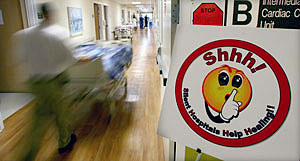May 26, 2009 - By Diane Rogers

The ‘SHHH' signs encourage Stanford Hospital staff members to keep the noise level low in patient areas.
In the medical nursing unit of Stanford Hospital & Clinics, the culprit turned out to be linen supply closet doors. Designed to close ever so quietly, they were actually banging shut at night - keeping patients awake.
To the rescue came the Night Shift Noise Reduction Project, armed with SHHH (Silent Hospitals Help Healing) signs. Instead of stuffing towels around the doors to deaden the noise, the signs urged nurses to call the General Services Response Center to adjust the door-closing mechanisms. Also helpful: unload supplies quietly at night, and be sure to keep your voices soft.
So, are patients now sleeping more soundly on the D-ground unit? 'We won't see data until June' when patient survey results come in for the pilot period, said Chuck Pitkofsky, RN, MSN, a member of the noise-reduction team. 'But anecdotally, nurse managers are telling us they feel it's quieter.'
When Pitkofsky, Jodi Blanchard, Dan Polcyn, Buffie Stark, Carlos Villalva and Carol Walovich were tapped last September to form a team and pick a project for the SHC Leadership Academy, they decided to go on an investigative mission - 'playing detective, to figure out the sources of noise,' as Pitkofsky put it. Four nursing units had scored poorly on the Picker survey, a national patient-satisfaction instrument that is mailed to patients after they are discharged. Responses to a question asking about noise levels had drawn consistently poor numbers in those units.
The noise-reduction team was expanded to include the nurse managers from the four units. Nighttime visits to those units with a decibel meter in hand confirmed that the causes of noise at the hospital were legion. Service carts rattled over threshold strips, HVAC units wheezed, water pipes burped, helicopters landed and took off, telephones rang, voices rose at nursing stations. Not to mention the endless beeps and bongs emanating from monitors, keypad codes and IV alarms.
'The alarms can't be turned off, and the noise can escalate from there,' said Myra Lang, RN, MS, CCRN, patient care manager of unit B2 for intermediate cardiac care. 'People talk more loudly to be heard over the alarms, and when a phone rings, you have to talk over that.'
Lang herself has been a patient at Stanford Hospital twice in recent years, and she brought a singular perspective to the questions asked by the noise-reduction team. While she said she felt more relaxed with her door open and hearing the noise of the unit, 'I expect noise, I live with it every day.'
The noise-reduction team looked at the kinds of noises they realistically could shush, and decided on some immediate 'interventions.' First came signage. SHHH posters were hung at nursing stations and at the doors to patient units, urging quiet with a stylized finger on cartoon-strip lips. The team also purchased two 'SoundEars,' LED displays in the shape of a human ear that light up - green, yellow or red - when noise thresholds are crossed. The 'ears' were rotated among the four pilot units, with 'a little module that sat on top, continuously monitoring the noise for a week,' Pitkofsky said.
Pitkofsky's own nursing unit sits above a first-floor construction project. In the early days of the project he went downstairs to the site to check out workers' earplugs. The team promptly ordered the same earplugs for hospital patients - bright orange foam plugs with a noise-reduction rating of 33.
Another intervention came from nurses' requests for the kind of pulse-oximeter probes that routinely are used in intensive care units to monitor oxygen levels in a patient's blood. The ICU probes are more expensive but also stay on patients' fingers better, thereby avoiding the alarms that sound if the probes inadvertently slide off.
Finally, each nursing unit was encouraged to appoint a 'noise champion' to be responsible for customizing noise-reduction strategies on his or her floor. Suggested bedtime routine as of 10 p.m.: dim hall lights, move nursing conversations behind closed doors, close patient room doors if possible and keep hallway conversations to a minimum.
Although the pilot project ended in April, Pitkofsky said a patient survey the team developed to detect sources of noise still is being distributed biweekly in a number of nursing units. 'And our recommendation would be to continue with the survey and the noise-reduction strategies, which we hope to roll out to the rest of the hospital,' he said.
About Stanford Medicine
Stanford Medicine is an integrated academic health system comprising the Stanford School of Medicine and adult and pediatric health care delivery systems. Together, they harness the full potential of biomedicine through collaborative research, education and clinical care for patients. For more information, please visit med.stanford.edu.